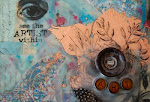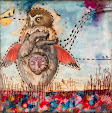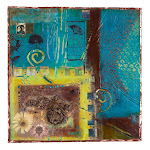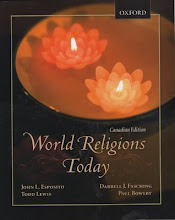Wax Libris - An encaustic exhibit celebrating the book, text and the written word.




Encaustic Altered Books above created by Supria Karmakar, " Guest House"
and " Ah What then?" 2009
Joanne's short essay on the exhibit follows below, with her permission, I am sharing this essay that expresses each artist's piece from Joanne's perspective. I love the flow of the words in this essay, the text is poetic and conjures visual imagery of each artists work.
For more visual examples of the artists work please explore their websites or blogs as linked here for you to enjoy. I have added some graphics of the artist's work; however, some of these are not the actual pieces of work that were exhibited in the "Wax Libris" exhibition. Unfortunately, I did not get to photograph images of the actual exhibit. Anything in the body within ( ) is my additional comments.
I feel deeply grateful to have been included in this opportunity to exhibit some of my work with such fabulous artists.....and a special hats off to Joanne who manages so much in a short time frame...She is the director of the Encaustic Painting conference, which I can only gather involves a lot of behind the scene hive of activity, we will never really be able to comprehend the buzz of activity that goes into putting together a magnificent event like this... Thank you!
Wax Libris - Short essay by Joanne Mattera
This small exhibition of artists' books, organized to run for the duration of the Third Annual Encaustic Conference at Montserrat, is set appropriately in the college’s Paul Scott Library. The artists invited to participate, conferees all, have produced objects that reflect the entire history of codified information, from the earliest clay tablets, here as words and lines scribed into wax, to scrolls and handwrought pages, to modern bound books. Some volumes are newly constructed by the artists, others transformed from library castoffs—all into works of poetry, mystery, beauty and wit.
Catherine Nash is a maker of geographically resonant objects. Their boxes and compartments include pages of handmade paper and materials such as roots, stones and cactus from the Tucson desert. Nash commits thought to form in an allegorical language of time and place.

"Boat Book" - By Catherine Nash, this is another book by Catherine Nash other than the one that was exhibited...
for some more glimpses of her work check out her website.
In Supria Karmakar’s beautiful volumes, poetry is a physical object, magic a tangible fact. With their doors and drawers, shrine-like niches, and profusion of pattern, hers are books to feel with the spirit as well as much as to read with the eyes.
Using encaustic collage, Jeanne Borofsky creates objects that are both book and icon. There is no textual narrative—pages are cut to be illegible, or actual text is obscured—so the viewer, aided by symbols and objects, is given to intuitive deciphering.

"The Key Inside" - By Jeanne Borofsky
Raymond Papka’s altered books might also be seen as “altared” books, icon-like objects meant to hang on the wall. Tapping into science, philosophy, music and math, Papka becomes a bit of an alchemist, turning tomes on those subjects into the embodiment of the ideas they represent.

"NewtonII" by Raymond Papka
With her handwritten narratives, Cherie Mittenthal, redefines the saints to fit her world view. In one of three works here, Ambrose of Milan, “patron saint of wax melters, encaustic artists and beekeepers ” is shown giving his blessing to a figure who looks very much like the artist herself.

"Patron Saint of Wax Melters" by Cherie Mittenthal
Cari Hernandez conjures the fiercest of longings from the simplest of words. A small handmade volume titled Permission suggests a minimalist prayer book. In it, words like peace, courage, love and surrender are by turns suggestion and supplication, mandate and meditation. (Her book can be viewed here!)
Julie Shaw Lutts creates miniature worlds in a box. A “daughter” of Cornell, she has staked out terrain distinctly her own, whether recollecting a visit to India or looking to a reinvented past. What surprises here is a side trip into humor: altered books aswim with fish, overflowing with rocks.

Julie Shaw's Altered books above and below

Daniella Woolf is a secret keeper. In two small collages, snippets of her daily journals are visible for all to see, but in their deconstructed compositions, the narrative remains known to the artist alone. Her small bound volumes exist entirely outside the literal, swatchbooks for visual thought. ( Her 'Rust book' can be viewed on her website under artworks - paper, here!)
While some artists make altered books, Sandi Miot makes what you might call altered paintings using cast-off books. Spines and pages seem to emerge from primordial thought itself, embodied here as a dense, dark field of graphite and wax. ( Check out her work here.)
My own work explores the formal and reductive elements of information: dot and line. Typically rendered in thread on wax, each “page” offers the viewer what I think of as tangible haiku. (Joanne's gallery of work can be viewed here!)
It’s a lovely irony that as we enter into an embrace of Kindle and its electronic kin, the resolute materiality of artists’ books and texts remains engaging and deeply satisfying — Joanne Mattera, curator
 For Jill's book, Designs in Nature, I chose to work on it using some new techniques I learnt at the Third Annual Encaustic Painting conference...I discovered the beauty of dipping paper from Cynthia Winika's demo at the conference...It is a great way to create delicacy ...I love Jill's theme, designs in nature..as there is so much beauty in nature to inspire creativity. I have embedded elements of nature that I consider inspirational...flowers, shells, spirals, patterns are everywhere when we look...
For Jill's book, Designs in Nature, I chose to work on it using some new techniques I learnt at the Third Annual Encaustic Painting conference...I discovered the beauty of dipping paper from Cynthia Winika's demo at the conference...It is a great way to create delicacy ...I love Jill's theme, designs in nature..as there is so much beauty in nature to inspire creativity. I have embedded elements of nature that I consider inspirational...flowers, shells, spirals, patterns are everywhere when we look...
 Jill's altered book is called "I Lift up My Lamp" and it is about Emma Lazarus, who is pictured above, and her role in bringing about the Statue of Liberty in New York. For more work by the Inner works collaborative artists visit the blog site here!
Jill's altered book is called "I Lift up My Lamp" and it is about Emma Lazarus, who is pictured above, and her role in bringing about the Statue of Liberty in New York. For more work by the Inner works collaborative artists visit the blog site here!




































































